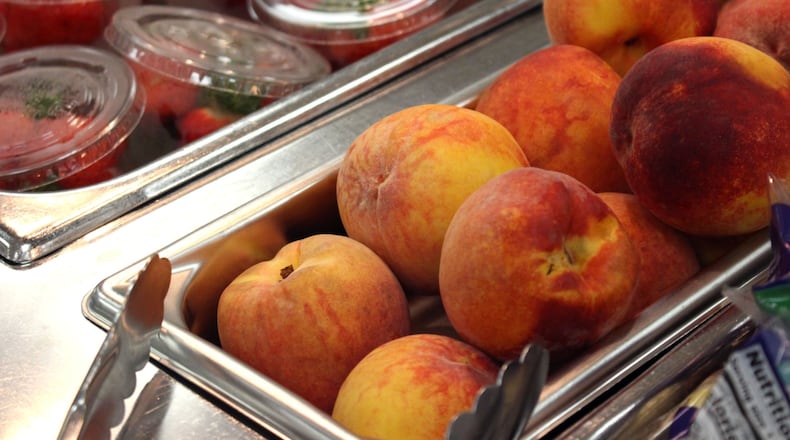If parents join their children at lunchtime during National School Lunch week (Oct. 15 - 19), they may notice the days of 'mystery meat' and the never-ending vat of creamed corn are gone. Today's school nutrition programs take into consideration changing palates, nutritional and budgetary guidelines and food trends.
One of the hottest trends among restaurateurs and foodies is increasingly reflected in school cafeterias. It’s the farm-to-table movement, where locally sourced produce, meats and other foodstuffs, often organic, are favored. Georgia students are right in the thick of this shift with farm-to-school, a similar strategy. The U.S. Department of Agrigulture says it’s good for child nutrition and community economic development.
In Georgia, the childhood obesity rate is 16.5 percent, according to the National Conference of State Legislatures; the food insecurity rate (lacking reliable access to a sufficient quantity of affordable, nutritious food) is 14.9 percent, according to the USDA Economic Research Service; and the rate of students receiving free and reduced-price meals is 62.4 percent, according to the National Center for Education Statistics.
Proponents say farm-to-school can address these issues.
Studies by Upstream Public Health, a nonprofit to help people lead healthier, fuller lives, show that every dollar spent on local food can generate up to an additional $2.16 in economic activity. School districts’ local food purchases can lead to over $1 billion in local economic activity over one school year, according to the USDA Farm to School Census.
The most current USDA Farm to School Census data show that in the 2013-2014 school year, five of Georgia’s largest districts spent nearly $9 million combined on locally grown food. While that sounds like a huge number, it’s only 10 percent of their food budgets. Gwinnett County, the state’s largest school district, spent 5 percent of its food budget with local vendors, while Cobb, the second largest school district, spent less than 2 percent.
But those numbers are climbing, say school nutrition directors, vendors and state agriculture advocates.
The data for 2017-2018 shows that statewide, schools spent more than $20 million on locally sourced food products. And more schools are looking to join the movement. Through programs such as Georgia Grown Test Kitchen (healthy recipes using Georgia products) and Feed My School for a Week (bridging the gaps in the nutritional value and quality of food served in Georgia schools, while providing more farm-to-cafeteria opportunities), 58 school systems are working directly with the state department of agriculture.
“Bringing Georgia fruits and vegetables into school cafeterias helps students and farmers. Students benefit from having fresh, nutritious produce on the menu. Farmers win by having a nearby market for the products they grow,” said Gary Black, state agriculture commissioner. “Students can also learn from this collaboration between farmers and schools. They will have opportunities to learn about Georgia’s geography, climate, soils, the crops we can grow here, and the importance of agriculture to our state. It is my hope they will also learn good eating habits and the importance of fruits and vegetables in our diet. Every situation is a learning opportunity, even lunch.”
The Georgia Farm to School Program was initiated by Georgia Organics in 2007. A Farm to School Alliance was established in 2009 with representatives from the Georgia Department of Agriculture and several other state agencies.
Gwinnett County Public Schools joined the Farm to School program in the 2010-2011 school year.
“We’ve gotten to the point where all of our green beans are fresh and from local producers,” said Karen Hallford, assistant director of school nutrition.
As of last school year, Gwinnett had 15 million servings of Georgia produce including pumpkins and strawberries from Alto, pickles made from cucumbers grown in Augusta as well as burgers and hot dogs topped with Vidalia onions from Toombs County.
Student feedback is an important part of the success, and the district utilizes focus groups and an app that allows ratings of various fare. That data is used to determine if a dish is a hit or a miss.
“Nothing is static when it comes to feeding students,” said Hallford. “It changes as tastes change. Our goal is for kids to have healthy meals that they want to eat.”
Since agriculture is Georgia’s largest industry, at more than $5.1 billion per year, much of what is grown is sent out of state. Being a part of the Farm to School program will allow farmers to sell closer to home, providing an additional marketing source for their business.
Royal Food Service distributes fresh produce and dairy products to many metro Atlanta school districts. Although it’s worked with schools for decades, the company has increased school contracts significantly in the past 12 years. About 10 percent of its business is with public schools.
The company’s range is mainly central/northern Georgia with some clients in Alabama, South Carolina and Tennessee. It’s a family-run operation that services restaurants, hospitals and hotels as well as schools. And while many people like the idea of farmers delivering their goods, Katie Whitehurst, one of the owners, said distribution is more complicated than that.
Routes must be planned and coordinated not only with customers’ hours of operation, but best delivery times. “It’s hard to get a big delivery truck on school grounds during carpool,” she said.
And with larger high schools, cafeterias may feed as many as 3,000 people a day, requiring two deliveries a week.
“Not many places would have the refrigerator space for that much food,” Whitehurst added.
The state department of agriculture encourages schools to reach out to local farmers/distributors and for companies to learn the guidelines to work with schools. Information: gafarmtoschool.org
About the Author
The Latest
Featured


